After the postponement two weeks back, the quarterly meet up with Richard from Shed West took place. We'd shot the 2nd Mantinea bolt with the three of us in his absence, so we needed to replace the centre piece game. I therefore dragged out my SCW gear and set up a game of "For Whom The Dice Rolls". After playing "It Rolls for Ivan" last week, I really felt like playing a proper game of this. With the four of us I eschewed umpiring, as felt I could rely on the players to remember how to play. I partnered up with Chris A, whilst Phil and Richard made a team.
There was a little bit of making sure I got out kit that hadn't been used before, and it was all a bit of a stretch. I considered setting up a protracted city fight, with lots of defendable blocks of buildings. In the end I chose to go for some slogging around in the hills of the Basque Country.
We are in a hilly area. A stream at low ebb meanders across the valley at the foot of the hills. The two bridges must be taken to allow for the passage of heavy weapons. The hedges represent the lip of sunken roads. The Basques and their allies are to the left, the Nationalists to the right.
The Basques have a three battalion brigade of Basque Army, two columns of Anarchist militia and some Asaltos. They are supported by some Trubia tanks, an Anarchist armoured car that really shouldn't be there, and a Bilbao APC with the Asaltos. They also had a battery of field guns.
The Nationalists had four Carlist Requetes, a Falange Tercio, a battalion of Panzer 1s and a big battery of howitzers. The Nationalists seem to have swapped out field guns for howitzers when fighting in the hilly/mountainous Basque region, so I thought it was fair to give it a go. The Carlists are better quality than almost everything else on the training front, and most units are very well motivated.
The Carlists march on to the table. Richard's second act is then to deploy his howitzers behind the village, and find some high ground for his observer. This will give us considerable difficulties all game. My Syborg 3D printed trucks I bought in bulk last year put in an appearance as artillery tows.
The Basque Army marches bravely on to the board. The curious playing card at the edge of the table is the One of Clubs in a Spanish playing card deck (no Aces in Spain!).
Phil on the Fascist right was using his Panzers aggressively (what a surprise) so we responded with our Anarchist shiny art deco wonder weapon. (NOTE: I am well aware these never got out of Catalonia, as far as I can tell, but it is new, and it is shiny and I wanted to use it.)
We also deploy our field guns, and hit a Carlist march column with our opening salvo.
Richard replies with his howitzers, targeting some Basques. These are the figures Jon F painted for me. And he does more damage than we did. Richard that is, not Jon.
Chris deploys one of his Anarchist columns in the sunken road. This gives as good cover as being in a trench, except it's straight, so you are in danger of being enfiladed.
Phil rushes our shiny tank with two Panzers. Our shiny but soft "armour" plating is no match for Nazi bullets.
The other Panzer tries to turn the flank of the Anarchists in the sunken road, and enfilade the line. As it emerges into the lane, a brave group as Anarchists attack it with grenades and petrol bombs. They are killed after an ineffective attack. They are swiftly followed by another group, who cause considerable damage, and then blow it up completely.
Here's a wide shot so you can get a handle on the action. On my flank I have lost the race to the village, but undaunted I have brought up my Trubias in preparation for a combined assault.
A round of firing, then in we go. What could possibly go wrong?
The outcome is very close. Factors are evenly matched. I realised after I did the attack that what I'd done was one of my rules test cases when balancing the factors, more or less. So a battalion attack on a battalion occupying buildings is equalled up by adding a tank section to the attackers. My guys were one pip down on the factors as the defenders have a slightly better Will to Combat. My failure to inflict enough casualties in the pre assault firing meant that whilst I outnumbered the defenders - each tank counts as three bases - it was not enough to get 2:1. I lost the dice roll off, and so was bounced back to my starting position. One of the tanks is damaged in the attack, and I take a few hits. When this picture was taken I hadn't added the hits to the defenders.
Things didn't get any better for me, as Richard switched his howitzers to pounding my newly repulsed troops. The tanks bugged out, retreating up the hill out of the way.
On the other flank both sides were bringing up troops.
The Panzers on the bridge had come under heavy fire from our field guns, and taken damage. Phil realised that if he left them there then they would just end up being destroyed on the position. He orders them forwards.
One tank stops to enfilade the troops in the lane (see below), and the other tries to overrun the Republican field guns. It wins the Close Assault dice off, and the guns are overrun.
However, one last desperate effort from the gun crews sees the tank destroyed in the process.
The other tank sees off one infantry close assault (see the dead marker) but is destroyed by close range HMG fire from the Bilbao armoured car.
Having roughed up his last target, Richard now switches his howitzers to my Basque unit in the centre. This is getting really tiresome.
Both sides are now set on our left flank. Chris has got all of his Anarchists in the sunken road, and Phil has his Falange hugging the river bank to hold the objective. He's taking a lot of fire, however.
Switching back to the other side, Richard charges out of the village to disperse our halted attack unit.
We resolve the artillery blast makers. I seem to have an overload of hit rings.
Yes. I do. My Brave Basque Battalion is wiped out to a man. Richard then drops back to the village...
...only for the Trubias to counter attack. It's a risky business, using armour unsupported, but it does the trick, and the Carlists are driven off, fleeing having suffered more damage and succumbing to tank terror.
Chris decides it is time to act on his flank. His two Anarchist columns unleash devastating fire, before storming the Falange.
They overrun the Fascists and throw themselves at the Carlists next to the bridge. This attack doesn't go so well, and they are roundly defeated.
In the centre Richard moves some Carlists up into position, so he can attack the Basques pinned by the Nationalist howitzers.
Alas my Trubias can't occupy and take the built up area. A fresh unit of Carlists move up and take the position, laying claim to the other objective again which is to their right rear.
Phil moves his Carlists up to re-occupy the river line.
Back to the centre, the bombardment is lifted, and the Carlists overrun the Basques.
Chris brings up his Asaltos, and close assaults the river line.
It's very close, but the Asaltos are driven back.
We now have one of those conversations about how much play we have left. It's 4:15pm, and we've been playing since about 11am, with a break for lunch and the odd tea & coffee. I reckon we're at the tipping point. Both armies are close to breaking. The Nationalists hold the bridge in the above picture, but on the other flank the Trubias have stormed past the village to dispute the other bridge and potentially to shoot up the howitzers (typically no picture of this). Richard has an untouched unit of Carlists, who have exited the village to try and turn our right flank. It could go either way. However, the way things have turned out, Phil is down to one unit and whilst the rest of us have fun he's reduced to a punching bag and in any event there's another game idea we were scheduled to put on the table. We therefore draw a line under it. Pity really.
I really, really, enjoyed this game, like I did with the game of IRFI last week. There was a lot of action and it played really well. Richard is a big fan of how it all works, and the other two had a good time as well. The card based command and control system makes players plan and prioritise. You know the turn is going to flip to your opponent and then flip back, and you have opportunities to focus on one area, or spread actions more widely. Yes. Really proud of how this plays.
The other game was a try out for a scenario based on a real live incident, with US troops making a beach landing to liberate part of Morocco occupied by the Vichy French forces. This is a really interesting incident, with the Americans not really knowing whether the French were going to resist or not.

Phil has brought some buildings and some French, and Richard some US forces. The rest of the terrain is extemporised from my terrain box. I knew those canal wharf sections would be useful eventually. Phil wants to use PBI for this. I don't have those rules (his are buried at home somewhere) but I do have the earlier PBI2, as does Richard, so we used them. This gave Phil some issues, as there are significant changes between the two (not, I would say, all for the better).

That's my bronze age temple pretending to be a souk. Those are also my XIVth Army Grants, making an appearance. Phil's kicking ideas around at the moment, so we are rolling for reinforcements. Personally I do not like this mechanism in scenarios, and I don't really like it in basic PBI/PBI2 either. As it turned out here we got the normal problems of troops turning up in the wrong order - way worse than would sensibly happen - several turns apart, and one force didn't arrive at all. I would deal with this by using playing cards, so that troops do turn up over a given time (eg each section has four playing cards such as 2,3,4,6. These are shuffled and one turned over each turn so you know they will turn up by turn 6, but not exactly when). As it was, Chris' flanking force never turned up at all, and my second wave armour turned up well before the first wave.
We eventually got some infantry ashore. There was more dicing for activation and/or motivation.
Then we got some artillery on the beach. If the jeeps look odd, they're from my AK47 Republic armies intended for 1950s Congo.
We then stopped as it was time to go to the pub for dinner. Phil is explaining here what actually happened and why it is really interesting. He's right, it is really interesting. There's a really good game in what happened. There area lot of edges to be smoothed off standard PBI to make this work, something Phil will no doubt do. This was very much a try out to see what worked and what didn't. Phil's plans for the game include modelling a beached naval destroyer and a souk with removable doors so you can blow them off, plus a proper airstrip and other amusing bits and pieces, so that'll be worth seeing.
And that was it. Another good day's wargaming.




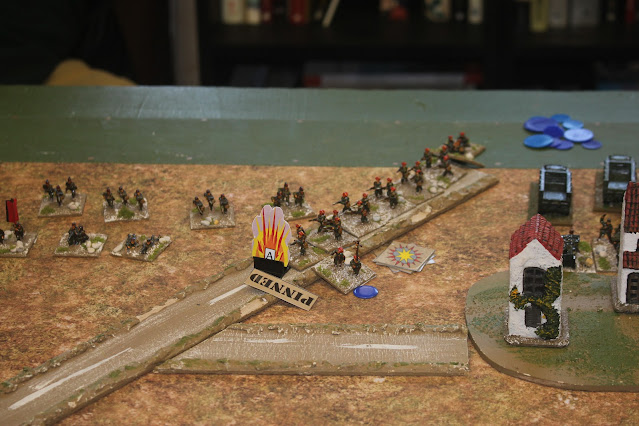













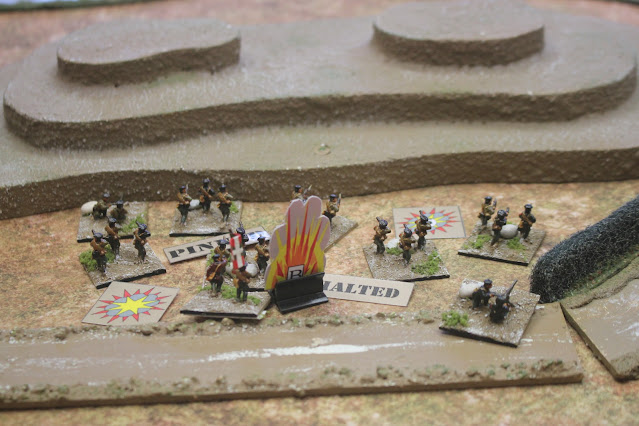
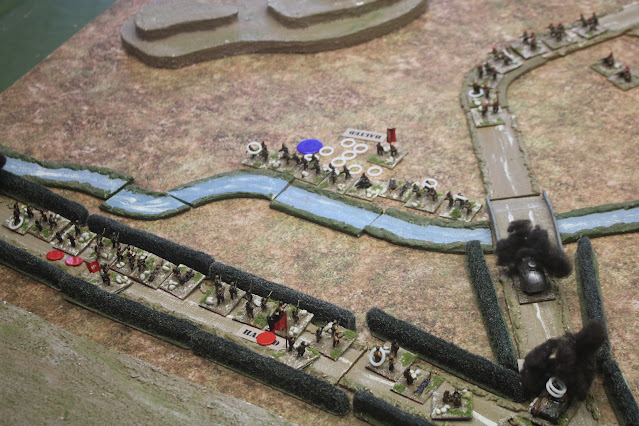








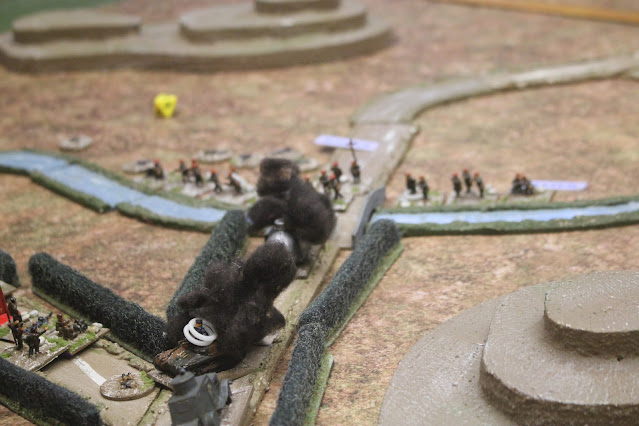





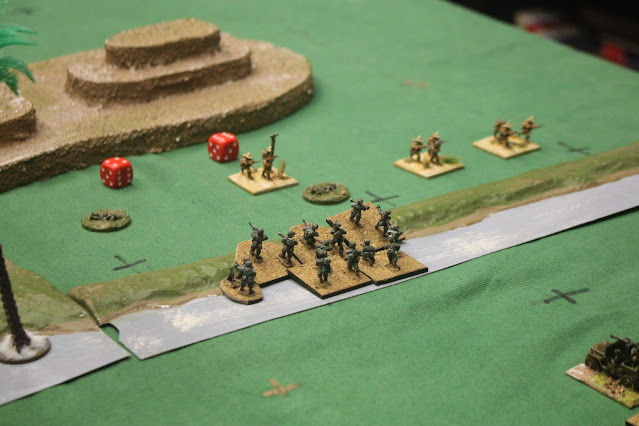


By the look and sound of it, a day well spent!
ReplyDeleteThinking about the off-table reinforcement, I infer that in the beach landing action they were intended as successive waves. Ballsing up the order was probably not that unrealistic if the officers supervising the procedure were not up to the job. I think I've read somewhere about a beach landing where some of the supplies got onto the beach before the lads did (an unopposed landing, I admit). But rather than dice for them at once, one method is leave over dicing for the second wave until the first is on its way, and that determines how long after the first wave the second sets off. If reinforcements were arriving up the one road, I'd probably use the same, or similar, method.
One of the methods I use is based upon the idea that a local commander will have some notion when he is likely to receive reinforcements (supposing he knows they are approaching). What I do it set an ETA in terms of game turns. Then roll a die.
1 - Reinforcements arrive 2 turns early (Jackson of the Valley)
2 - reinforcements arrive 1 turn early
3-4 - reinforcements arrive on time
5 - reinforcements arrive 1 turn late
6 - reinforcements arrive 2 turns late (Jackson of the Chickahominy)
One also has to be mindful that war games probabilities have little to do with mathematical probabilities. We all know how D6s are supposed to behave. Well, in war games, they don't. Suppose you are rolling for - OK, reinforcements - requiring a 6 for them to show. You will have
1. Chance of rolling a 6 first up: 50-50
2. Chance of never rolling a 6: 50-50
3. Chance of a 6 turning up at some other time; 50-50.
The goddess Hexahedra is a most capricious wight.
Cheers,
Ion
Phil reads these posts from time to time, so hopefully he'll pick up on your suggestions.
DeleteWhat? “Wargame probabilities have little to do with mathematical probabilities”? While the output in your example may be binary, the input function certainly is not and follows a frequentist path.
DeleteExactly what I was going to say.
DeleteHa. Yeah, I simply beat you to the punch!
DeleteAnd on my own blog too!
DeleteThat SCW game looks fun. By the way, on which side are these Frequentists that Jon mentioned?
ReplyDeleteFrequents fight on the side of truth and follow the Law of Large Numbers.
Delete@nanducket: The SCW is a really interesting period. It is modern without getting overly complicated, and mostly it is manageable in size, without having to reduce it to the inevitable skirmish game. "For Whom The Dice" rolls not only has the rules in it but a load of handy stuff like force lists and a good bibliography.
Delete@Jonathan Freitag: I went and read the Frequentist definition on Wikipedia. I am now in the category of being better informed but none the wiser.
Graham, lucky for you that I did not suggest wandering off down the Bayesian path...
DeleteControversial.
Delete